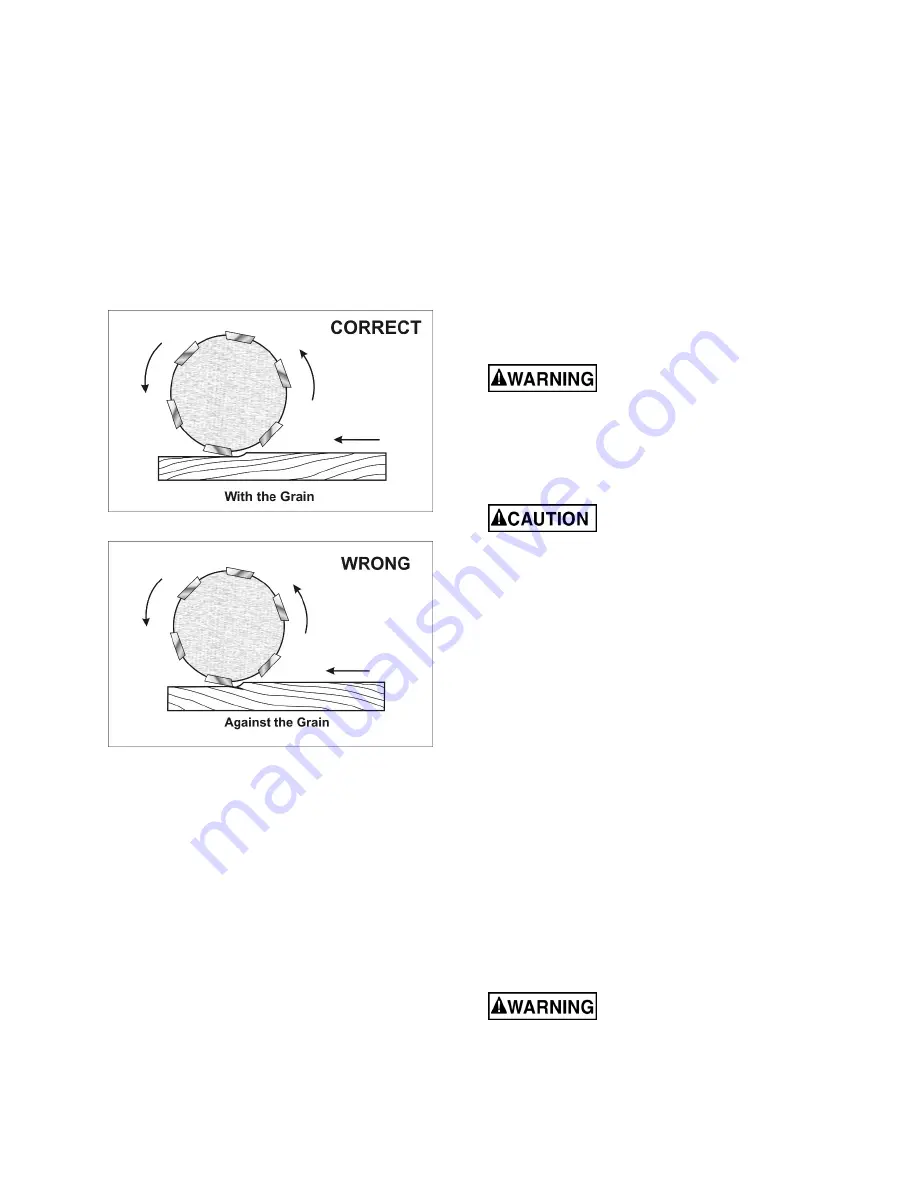
13
TIP:
On rough lumber, you may need to rip one
edge on a table saw or band saw to more easily
observe a board’s grain direction. Also, the grain on
some wood species may change direction in the
middle of the board – if possible, cut the board in the
middle so the grain direction will be consistent on
both pieces. Otherwise, use personal judgment as
to which direction is more favorable, and safer, for
feeding.
Edge grain (see Figure 9-2) may be planed if the
stock is wide enough to rest firmly upon the table.
Do not attempt to plane end-grain
(see Figure 9-
2) as this can result in splintering of the stock and
potential kickback.
Figure 9-3
Figure 9-4
9.8
Knots and trouble spots
Wood with knots, “wild” grain, or extensive figuring
is always difficult to surface and requires extra care.
Check that any knots are solid. Do not plane stock
with loose knots. Take light cuts. Be especially
cautious of kickbacks and stop cutting immediately
if the board will not feed smoothly.
9.9
Snipe
Snipe refers to a depression at either end of the
board caused by an uneven force on the cutterhead
when the work is entering or leaving the planer.
Snipe may occur when the board is not supported
properly or when only one feed roller is in contact
with the board at the beginning or end of the cut.
If the snipe is deep, be more careful how the board
is supported. Keep it parallel to and flat on the table
at all times. Use an extra support, such as a roller
stand, at both the infeed and outfeed ends of the
planer.
Other methods to prevent snipe are reducing the
depth of cut, and feeding additional boards butted
closely to leading and trailing ends of the workpiece.
If snipe cannot be avoided, cut the material longer
than needed and trim the ends after planing.
9.10
Ridges
Damaged or nicked knives can leave ridges along
the length of a board.
Always inspect each board carefully before
attempting to plane it. Do not attempt to plane
second-hand lumber with nails below the surface,
painted wood, plywood, hardboard, wood with a
glue bead, or any material other than solid wood.
Do not attempt to plane
second-hand lumber, painted or varnished
wood, plywood or particle board. These
materials can damage planer knives. Failure to
comply may cause serious injury.
9.11
Planing rough lumber
Make sure wood is properly
dried before planing. Wet or “green” lumber may
clog the machine and lead to damage.
Air dried wood should stand for at least a year per
inch of thickness of the rough cut stock. The
moisture content of air dried wood should be about
12% to 15%. Kiln dried woods should have a
moisture content of approximately 10%. Wood to be
used in fine furniture should have a moisture content
of 7% to 8%.
Joint one edge of the rough cut lumber before
planing. This will help you determine the direction of
grain travel. Feed the board into the planer so the
knives cut with the grain, see Figure 9-3.
Measure the rough lumber at several locations to
find the thickest part. As wood dries, its dimensions
vary, including its thickness. Set the planer to take a
very shallow cut on the highest, thickest part of the
board. Continue to take very shallow cuts until you
can determine whether there are any knots or
unusual grain patterns.
After completing one side, inspect the opposite side
for irregularities, then process it using the same
procedure as for the first side.
9.12
Planing glued-up boards
Glued-up stock must dry at
least 24 hours before being planed. Failure to
comply may cause the stock to separate in the
planer, leading to kickback and serious injury.














































